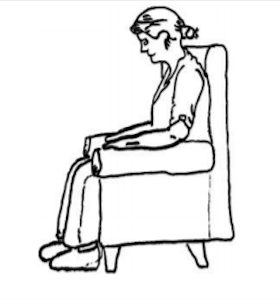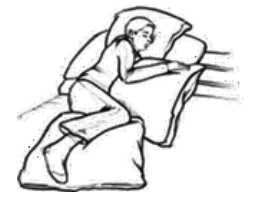Managing breathlessness
Many conditions, such as heart or lung diseases, cause breathlessness.
Breathlessness can be very frightening and distressing, even in milder cases. The following steps may help you feel less breathless. You might find some of these steps more helpful than others. Try them out and use the ones that you find most helpful:
Finding a comfortable position to ease your breathlessness
Sit upright in a comfortable armchair with both arms supported on the sides of the chair or cushions. Let your shoulders drop and relax. Rest the soles of your feet on the floor.

Sit on a chair and let your body flop forwards. Rest both arms on a table or your knees to support you.

Lie on your side propped up with pillows under your head and upper body. Tuck the top pillow into your neck to support your head. Rest your top arm on a pillow placed in front of your chest and your top leg on another.

Managing your breathing
In your comfortable position, loosen your wrists, fingers and your jaw.
Abdominal and tummy breathing
Rest a hand on your tummy and breathe in gently to feel your tummy rise. Then breathe out slowly through your nose or your mouth. Rest and wait for the next breath to come. You may find it helpful to purse your lips while you breathe out slowly. It may help you to imagine you are making a candle flame flicker, without blowing it out fully.
Slowing down
When you are comfortable with the tummy breathing, try to slow down the speed of your breathing. When you slow down, your breathing becomes deeper and more efficient. Imagine air filling your tummy like a balloon. You can practice this technique regularly so that it becomes easier when you feel breathless.
Breathe a rectangle
- Once you have found a comfortable position, look around for a rectangle. This might be a window, a door, picture, or even a book or television screen.
- Now follow the sides of the rectangle with your eyes as you breathe, breathing in on the short sides and out on the long sides.
- Gradually slow the speed that your eyes move round the rectangle, pausing at the corners to help slow your breathing.

Cooling the face
Cooling the face, especially around the nose, can help reduce how breathless you feel. Try wiping a cool wet flannel on your nose and upper cheeks of your face.
Tips for living with breathlessness at home
When walking
- Move at a comfortable pace, and breathe steadily
- Avoid holding your breath, or trying to move or turn too fast
- Pace your breathing to your steps; breathe in for one step, breathe out for the next two steps
- Use walking aids if they help you
- Stop and rest whenever you need to.
When climbing steps or stairs
- Use the handrail when climbing stairs and take the steps slowly. Try resting for at least five seconds every few steps.
During day-to-day activities
- Keep things you use often close to you
- Have a charged phone close to your bed or armchair
- Plan ahead with your chores or daily activities, such as bathing or housework
- Spread your activity throughout the day
- Have everything you need before you start an activity
- Rest between activities or when your breathing begins to feel uncomfortable
When feeling anxious
- There are many ways to deal with worried feelings. These include mindfulness, listening to relaxing music, or doing gentle activity such as gardening, yoga, singing or reading a book.
When eating and drinking
- Take small meals often, rather than one large one
- Eat smaller mouthfuls
- Avoid foods that are difficult to chew; add sauces when possible
- Drink little and often, particularly water, to avoid becoming dehydrated.
Keep active
- It is important to stay as active as you can, to prevent your muscles becoming weaker.
It is okay to ask for help. Please contact your usual health and social care teams if you need further support.
Findings from the BETTER-B project
The EU-funded BETTER-B project, which ELF was a partner in, concluded with findings that an antidepressant did not help long-term breathlessness. The BETTER-B project looked at the antidepressant mirtazapine. The findings highlight the need for options to treat the symptoms of severe breathlessness, as there are no drugs licensed for this in most countries.
A practice review was published to provide recommendations on using medications to treat breathlessness.
Read a lay summary of the recommendations
Additional resources
Further resources for people with breathlessness:




